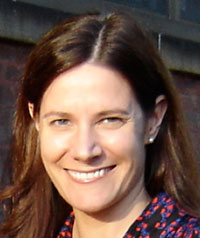Newsroom Archive
 Assistant Professor of Department of Sociology and Interdisciplinary Studies Program Lucia Trimbur’s new book, Come Out Swinging, is the culmination of twelve years of research on one of Trimbur’s lifelong passions: boxing. As a runner on her college track team, Trimbur and her team would regularly watch big fights and follow major fighters.
Assistant Professor of Department of Sociology and Interdisciplinary Studies Program Lucia Trimbur’s new book, Come Out Swinging, is the culmination of twelve years of research on one of Trimbur’s lifelong passions: boxing. As a runner on her college track team, Trimbur and her team would regularly watch big fights and follow major fighters.
“I’ve always liked boxing, and I was interested in its racial history, class history, then in 2001 when women just started participating in boxing, I became interested in the gender history and how women were being incorporated into the sport,” said Trimbur.
In many ways clients of the gym are seeking different ways to express themselves and find new identities through their bodies. The sport of boxing draws people who desire discipline and regimentation. “It structures your day and people who crave that do really well. You do it on your own. Dig deep and find yourself and I think people are driven to that. It requires so much,” said Trimbur.
The book investigates the socio-economic relationships that function and sustain the world-famous Gleason’s Gym in the DUMBO-district of Brooklyn whose roster of alumni includes heavyweight champs, such as Muhammad Ali and Mike Tyson. The owner of Gleason’s Gym, its third since its founding in 1937 in the Bronx, accepted Trimbur’s request to conduct graduate research on the distinctive community that has shaped, and is shaped by, the world’s first boxing gym.
The demographics of Gleason’s Gym, now located in one of New York City’s most expensive areas, is drastically different from the working class, mostly Irish immigrant membership base of its Bronx forbearer in the thirties and forties. According to Trimbur, Gleason’s has survived where other boxing gyms have shutdown, because it remains open and accepting to diverse members, aiming to keep as many people coming through it doors as possible. Today 65 percent of the gym’s members are comprised of wealthy white collar men, 200 women, and amateur boxers, primarily young men of color, many of whom were recently released from prison.
Trimbur began to train and spar with trainers as she conducted research, spending 70 hours a week in the gym.
“The book looks at four groups of people: amateur boxers, trainers, white collar clients, and women, and how they come together in the gym and how they make the gym happen. This book looks at what they hope to gain out of the sport of boxing, what in their personal histories have lead them to boxing and how they do or do not work together as a community. For each group they have a particular motivation, that they actualize something in the gym and in return boxing gives them something,” said Trimbur.
The gym offers respite for people who have recently been released from prison because as Trimbur says the gym is like an informal site of reentry where individuals can receive empathy, support and validation that they may not receive from the community. Many women are drawn to the gym because they are victims of abuse or domestic violence and are striving to develop physical strength and stronger senses of selves. White collar clients are relatively recent additions the gym community. Their monetary contribution sustains the gym and allows trainers to work full-time while they receive a renewed sense of masculinity from their otherwise emasculating corporate office jobs.
“Everyone is looking for new identities; this gym gives people that. It’s like a snapshot of how people respond to structural circumstance, how we understand New York City, women integration, and prisoner reentry,” said Trimbur.
For more information about the book, click here.
 Inside JJC (Faculty & Staff)
Inside JJC (Faculty & Staff) Technology Services Status
Technology Services Status

